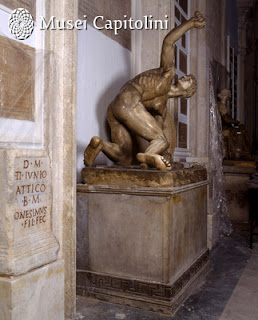This sculptor, although born in France (1657) spent all his life in Rome from the age of 10 until his death (in 1733).
He got his first sculpture lessons from his father who sculpted wood, then by Jean Dubois, and may have worked a little in Paris for some main sculptors on some projects launched by the King Louis XIV.
Once in Rome, he joined quickly a circle of French sculptors, who gradually would get an excellent reputation during the first part of the 18 century, and got many commissions, not only for Italian monuments & churches, but also for English aristocrats, for whom he sculpted tombs monuments, allegorical figures for chapels, and mythological pieces.
He also went to Kassel in 1714, where he sculpted several statues, busts and a masterpiece consisting of colored marble bas-reliefs in the Orangerie at the Karlsaue.
 |
| Cupidon & Narcissus - Kassel |
 |
| Apollo & Marsyas - Kassel |
But Monnot transformed that figure (a liberty used at the Baroque period) to make it as the Wounded Warrior, ''who supports himself on his arm as he sinks to the ground''.
It is the Pope Clement XII who offered that sculpture to the Capitoline Museum.
(This sculpture was seen last week in Rome by one of our regular reader from Paris, P., who kindly sent me a picture, together with a funny anecdote : the guide apparently did not liked when he tried to go at the back of the statue, to admire the other side, so here are 2 more pictures to help him!).
Together with this sculpture, today's bonus is the second marble sculpture at same Museum, showing one of the Niobide, also 'appreciated' by our reader!
 |
| Niobide - Capitoline Museum - Roma (photo P. from Paris) |
Sources:
Wikipedia
Capitolini Museum

















